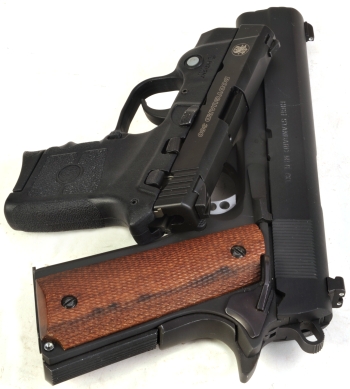
As a gun geek, I’ll sometimes buy a handgun for the sole reason it’s fun to shoot or because it has an interesting design. As a practical matter, I also believe in the use of handguns for self-defense. I’ve been around long enough to know that both interests are not typically served with the same firearm.
Medium frame 357 S&W magnum revolvers and full size autoloaders in .45 ACP or 40 S&W do well as strategically stowed defensive handguns. The heft of a recoil- absorbing big gun, a hard hitting cartridge and lots of capacity are appropriate and manageable for this application. Carry guns, however, have consistently grown smaller in size and in caliber for many, dictated by: concealment concerns, carry convenience and the enhanced performance of bullets designed specifically for the smaller round for use in a short barrel firearm.
It took some time for me to accept that a firearm with a lesser cartridge than the 40 S&W could do more than serve as a source of entertainment… for both shooter and perpetrator. But after spending a good deal of time at the range testing firearm reliability and accuracy, then lab testing ammunition performance in terms of accuracy, external and terminal ballistics, a mountain of empirical data convinced me that there is a place for 9mm and 380 ACP guns in the critical job of self defense. All it takes is the right gun and the right ammunition.
The S&W Bodyguard 380
The Standard Catalogue of Smith & Wesson indicates the model designation “Bodyguard” was first applied to a S&W Model 38 as the “Bodyguard Airweight” in 1955, a compact double action revolver with the hammer recessed to prevent it from snagging on clothing when the gun is drawn. So there is some tradition in the Bodyguard name and probably some common intent of design; a reliably lethal firearm in the most reasonably concealable form.

|
||||||||||||||||||||||||||||||||||||||||||||
The Bodyguard 380 is a short recoil, camming locked breech autoloader. The gun does not have a magazine disconnect, so it can be fired with a round in the chamber and magazine removed. The breech end of the barrel has a small “U” notch to permit unloaded/loaded condition checking.
The Bodyguard is very complete for such a compact 380 ACP autoloader. Even setting aside the Bodyguard’s Insight laser aiming device and drift adjustable metallic sights, controls are in place that are typically only found on more full size autoloaders; thumb safety, slide stop lever and an actual takedown lever. Subsequently, handling the Bodyguard – loading, shooting and disassembling, has a much more intuitive feel and the firearm can be field stripped without the use of tools.
The pistol is supplied with a both flat and grip extender floor plates. I do believe the extender floor plate serves a useful purpose by supplying positive ring finger support. While the 380 ACP is not much of a recoiling cartridge, finesse hand control is required. Especially when it is a handgun of this small size and light weight, with a 5/8″ long and 10 Lbs trigger pull to navigate. Not to the detriment of accuracy, I would still describe the Bodyguard’s trigger pull as… suspenseful.
A little closer look at features…
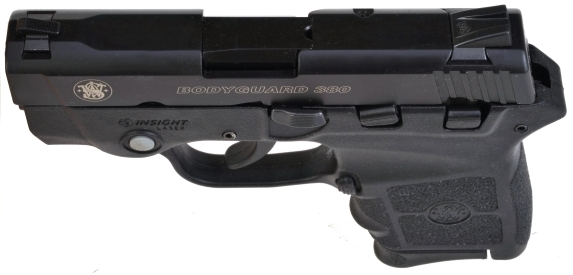
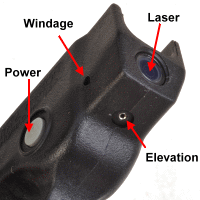 As indicated by a good set of drift adjustable metallic sights and an integral laser sight, the Bodyguard is made to be shot through sights. The metallic sights are low profile and contoured to minimize snagging on clothing. They offer a sharp, high contrast sight picture.
As indicated by a good set of drift adjustable metallic sights and an integral laser sight, the Bodyguard is made to be shot through sights. The metallic sights are low profile and contoured to minimize snagging on clothing. They offer a sharp, high contrast sight picture.
The Insight laser has provisions for both windage and elevation adjustments, both accomplished externally with a small hex wrench. The Laser sight is switched on and off by pinching the two gray buttons on the side of the frame in unison. Laser sight battery service is accomplish with the gun in basic field stripped condition. The battery access panel is in the forward part of the frame’s barrel channel, secured with a small hex head screw.
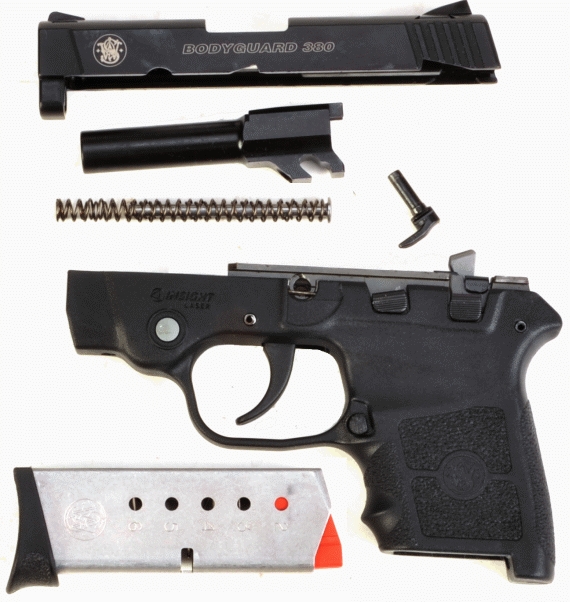
Overall, the Bodyguard 380 is a well-made firearm. There is a notable absence of plastic parts, with the exception of the frame, and there is a cast alloy frame insert that manages alignment and fit of critical fire control parts and other assemblies. The frame insert also provides a good deal of bearing surface area for the slide’s rails. This full support, no doubt, contributes to the gun’s accuracy.
What really counts…
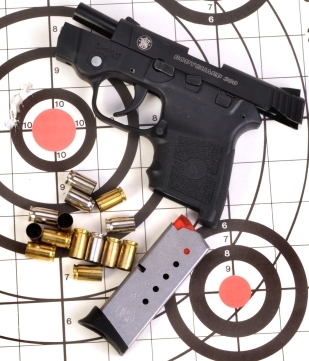
The Bodyguard is a slick cycling autoloader, something not typical of very compact 380 ACP firearms. In this case, the Bodyguard easily handled PMC 90 grain FMJ, Remington 102 grain Golden Saber and Hornady 90 grain FTX. The various types of ammo were loaded and fired as discrete and mixed magazine loads to check function and accuracy.
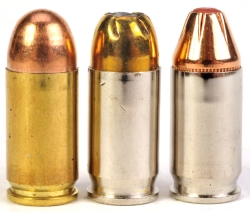
All shooting was done from seven yards, which I believe is a reasonable distance for this type and caliber of firearm. Both metallic and laser sights were used during testing. All shooting was done from a two hand hold which, surprisingly, is easy to accomplish and completely eliminated the feel of a short gripped gun. Unlike every other 380 autoloader I’ve shot, the Bodyguard trigger guard is squared at the front which makes for an excellent hold.
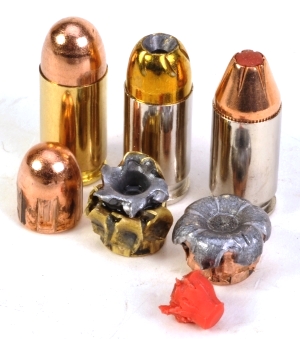 At seven yards, shooting two groups of three shots from each magazine, all shots stayed inside of an inch. Didn’t matter which ammunition. Didn’t matter if it was mixed ammunition. I did notice that ball ammo seemed to form a tight string, where the expanding tip bullets tended to form in a small circular group. Again, all under an inch. For such a small round, the gun slaps a bit, probably a function of the narrow grip, but it stays put in the hand and doesn’t cause a shift in grip.
At seven yards, shooting two groups of three shots from each magazine, all shots stayed inside of an inch. Didn’t matter which ammunition. Didn’t matter if it was mixed ammunition. I did notice that ball ammo seemed to form a tight string, where the expanding tip bullets tended to form in a small circular group. Again, all under an inch. For such a small round, the gun slaps a bit, probably a function of the narrow grip, but it stays put in the hand and doesn’t cause a shift in grip.
Using a standard Ballistic Test Tube, Brownells#100-002-900 for penetration testing, set at ten feet, bullet expansion was very good 0.471″ for the Golden Saber load, center, and the Hornady FTX 0.502″. The FMJ bullet came out like a FMJ, 0.353″ as expected. The plastic tip from the Hornady round was flattened in the shape of the expanded bullet, but it recovered near original shape when rinsed in hot water.
Penetration was not minor. The PMC ball went 8″ into the medium, the Golden Saber 5″ and the Hornady 4 ¼”. No, they won’t blow the block out of a truck or shoot through a tree on the way to a target, but in close quarters, in settings where there may be other people present, this may be all the penetration desired. For context, the recorded velocity of the ammunition was PMC 867 fps, Hornady 993 fps and Remington 802 fps. Factory published velocities for these rounds are 920 fps, 1000 fps and 940 fps respectively.
Conclusion
I know, you thought we’d never get here. S&W did a good job creating a compact autoloader that is about optimal for the 380 ACP. In doing so, they shook off all of the typical ailments found in similar combinations. The Bodyguard is so compact and light it carries as though it isn’t there, but it is as easy to shoot as a full-size autoloader when needed.
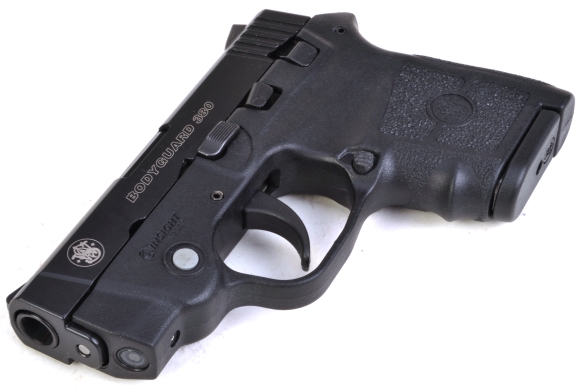 .
.
I don’t know how I feel about the laser sights as I am not a laser sight kind of guy. For me it is easier to pick up a target through the large metallic sight profile than it is to find the small red dot on a target. I also don’t like having a light projecting from the front of a gun, but that’s just me. I will say that practicing with the laser proved to be fun and keeping the dot steady improved my overall proficiency with the gun. If there is an 380 ACP to consider, this would be a good place to start.

Email Notification